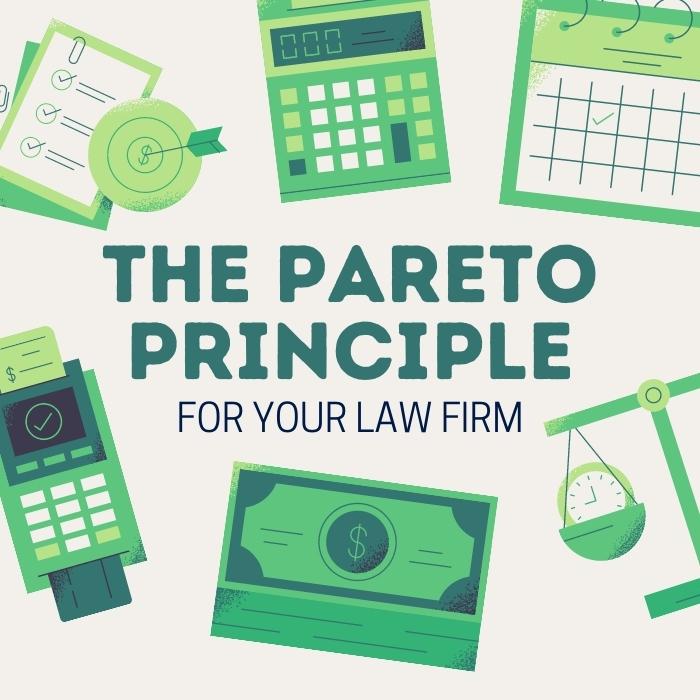
The Pareto Principle (80/20 Rule) for Lawyers
When you’re first introduced to the Pareto principle, it can sound metaphysical…even magical.
But the more you investigate within your own law practice how the Pareto principle applies, the more you’ll discover that this “80/20” thing you’ve heard about? It’s actually legitimate.
In this article I want to talk to you about something that isn’t totally marketing.
The Pareto Principle Concept
You’ve likely heard of it before as the “80/20 rule” or the 80/20…something. Regardless, the original concept was called the Pareto principle, and the basic idea is that 20% of what you do generates 80% of the results. Conversely, the remaining 80% of what you do produces only 20% of your results. Simple enough, right?
 Looking at Both Sides
Looking at Both Sides
You might be tempted to focus only on what constitutes this 20% of high-performing inputs. After all, this category produces the greatest profits at the lowest cost! However, it’s important to look at both sides of this ratio and also identify what makes up the remaining 80% of lower-benefit activities. From there you can gradually reduce the amounts of excessive activity that you undertake.
How Does the Pareto Principle Apply to Your Law Firm?
A principle like this may sound more relevant to a place where you can easily manipulate numbers. An example could be a large business selling one product and figuring out overhead, ideal customers, and cost of acquisition.
But how does this apply to your law firm?
Within your law firm, the very first application of the Pareto principle which I would look at is the simple idea that 20% of your clients are worth roughly 80% of your revenue. This is especially true in any law firm that has variable pricing. For example, in a personal injury practice there are many serious accidents that take up less of your time yet produce the highest payoffs. The remaining 80% of your time is usually spent on clients with average returns.
This doesn’t sound like the best bargain for you overall…so what can you do to fix it?
- Determine which types of clients make up your top 20% of earnings and market to them.
- Evaluate how you spend your time and determine what you do that generates the most value. Value here can mean the money you make or the time you spend making money.
These two steps eliminate time and resource-wasting efforts within your firm and your workday. As you identify the most valuable clients and uses of your time, the top 20% of worthwhile activities will eventually grow to almost 100%.
What the Pareto Principle Looks Like Practically
In the context of time management, the Pareto principle allows you to delegate lesser responsibilities to lower-level staff or external workers/programs. Something like fixing a broken copier should not be the responsibility of a top attorney and is not a worthwhile use of that lawyer’s time. The Pareto principle distinguishes actions that deliver measurable value to your firm.
In the context of office management, the Pareto principle allows you to define and structure your firm’s levels of operation. As you delegate the 80% of work that yields fewer measurable benefits to subordinate employees, your top-performing 20% of activities grows to occupy 100% of your time. A new top 20% of activities then forms, and as this process is repeated, departments within your firm are created and optimized for highest efficiency and effectiveness.
At the same time, your profit, position, and personal autonomy continue to grow and grow again. That’s the amazing thing about this principle–you execute based on the initial 80/20 application, and your growth continues after every additional application and adjustment.
Although this principle does sound magical or even metaphysical, the truth is that it simply follows mathematical principles. And as boring as math can be, it should inform smart decisions.
Thus the Pareto principle is an extremely powerful tool for your law firm…when you diligently apply it.

Most attorneys start their firms assuming that being a really, really good attorney should, in and of itself, be a marketing advantage. Those attorneys believe that joining a whole bunch of committees and putting their name in lawyer directories is “marketing,” and they never bother to ask if there is a better way.
Attorneys are catching on, however, and those who succeed learn to leverage their current resources to create effective (and ethical) marketing. What they discover isn’t a magic pill or silver bullet but a different approach to marketing that your competitors haven’t considered.
If you want a peek at what successful attorneys use to market their practice, the HERO Starter Kit is your logical next step.
We’ve put together a FREE (and potentially life-changing) kit for solo and small firm attorneys that will show you a better way to reach potential clients and get them excited to call your firm. Request your HERO Starter Kit from Great Legal Marketing!
by Ben Glass
Ben is a nationally recognized expert in attorney marketing and the owner of Great Legal Marketing.
